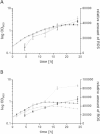Role of oxygen and the OxyR protein in the response to iron limitation in Rhodobacter sphaeroides
- PMID: 25220182
- PMCID: PMC4176601
- DOI: 10.1186/1471-2164-15-794
Role of oxygen and the OxyR protein in the response to iron limitation in Rhodobacter sphaeroides
Abstract
Background: High intracellular levels of unbound iron can contribute to the production of reactive oxygen species (ROS) via the Fenton reaction, while depletion of iron limits the availability of iron-containing proteins, some of which have important functions in defence against oxidative stress. Vice versa increased ROS levels lead to the damage of proteins with iron sulphur centres. Thus, organisms have to coordinate and balance their responses to oxidative stress and iron availability. Our knowledge of the molecular mechanisms underlying the co-regulation of these responses remains limited. To discriminate between a direct cellular response to iron limitation and indirect responses, which are the consequence of increased levels of ROS, we compared the response of the α-proteobacterium Rhodobacter sphaeroides to iron limitation in the presence or absence of oxygen.
Results: One third of all genes with altered expression under iron limitation showed a response that was independent of oxygen availability. The other iron-regulated genes showed different responses in oxic or anoxic conditions and were grouped into six clusters based on the different expression profiles. For two of these clusters, induction in response to iron limitation under oxic conditions was dependent on the OxyR regulatory protein. An OxyR mutant showed increased ROS production and impaired growth under iron limitation.
Conclusion: Some R. sphaeroides genes respond to iron limitation irrespective of oxygen availability. These genes therefore reflect a "core iron response" that is independent of potential ROS production under oxic, iron-limiting conditions. However, the regulation of most of the iron-responsive genes was biased by oxygen availability. Most strikingly, the OxyR-dependent activation of a subset of genes upon iron limitation under oxic conditions, including many genes with a role in iron metabolism, revealed that elevated ROS levels were an important trigger for this response. OxyR thus provides a regulatory link between the responses to oxidative stress and to iron limitation in R. sphaeroides.
Figures



Similar articles
-
Role of the Irr protein in the regulation of iron metabolism in Rhodobacter sphaeroides.PLoS One. 2012;7(8):e42231. doi: 10.1371/journal.pone.0042231. Epub 2012 Aug 7. PLoS One. 2012. PMID: 22879920 Free PMC article.
-
IscR of Rhodobacter sphaeroides functions as repressor of genes for iron-sulfur metabolism and represents a new type of iron-sulfur-binding protein.Microbiologyopen. 2015 Oct;4(5):790-802. doi: 10.1002/mbo3.279. Epub 2015 Aug 1. Microbiologyopen. 2015. PMID: 26235649 Free PMC article.
-
The sRNA SorY confers resistance during photooxidative stress by affecting a metabolite transporter in Rhodobacter sphaeroides.RNA Biol. 2015;12(5):569-77. doi: 10.1080/15476286.2015.1031948. RNA Biol. 2015. PMID: 25833751 Free PMC article.
-
Iron and oxidative stress in bacteria.Arch Biochem Biophys. 2000 Jan 1;373(1):1-6. doi: 10.1006/abbi.1999.1518. Arch Biochem Biophys. 2000. PMID: 10620317 Review.
-
Singlet oxygen stress in microorganisms.Adv Microb Physiol. 2011;58:141-73. doi: 10.1016/B978-0-12-381043-4.00004-0. Adv Microb Physiol. 2011. PMID: 21722793 Review.
Cited by
-
sRNA-mediated RNA processing regulates bacterial cell division.Nucleic Acids Res. 2021 Jul 9;49(12):7035-7052. doi: 10.1093/nar/gkab491. Nucleic Acids Res. 2021. PMID: 34125915 Free PMC article.
-
6S RNA in Rhodobacter sphaeroides: 6S RNA and pRNA transcript levels peak in late exponential phase and gene deletion causes a high salt stress phenotype.RNA Biol. 2017 Nov 2;14(11):1627-1637. doi: 10.1080/15476286.2017.1342933. Epub 2017 Sep 13. RNA Biol. 2017. PMID: 28692405 Free PMC article.
-
The Conserved Dcw Gene Cluster of R. sphaeroides Is Preceded by an Uncommonly Extended 5' Leader Featuring the sRNA UpsM.PLoS One. 2016 Nov 1;11(11):e0165694. doi: 10.1371/journal.pone.0165694. eCollection 2016. PLoS One. 2016. PMID: 27802301 Free PMC article.
-
The small DUF1127 protein CcaF1 from Rhodobacter sphaeroides is an RNA-binding protein involved in sRNA maturation and RNA turnover.Nucleic Acids Res. 2021 Apr 6;49(6):3003-3019. doi: 10.1093/nar/gkab146. Nucleic Acids Res. 2021. PMID: 33706375 Free PMC article.
-
Regulation of a polyamine transporter by the conserved 3' UTR-derived sRNA SorX confers resistance to singlet oxygen and organic hydroperoxides in Rhodobacter sphaeroides.RNA Biol. 2016 Oct 2;13(10):988-999. doi: 10.1080/15476286.2016.1212152. Epub 2016 Jul 15. RNA Biol. 2016. PMID: 27420112 Free PMC article.
References
-
- Storz G, Zheng M. Bacterial Stress Responses. Washington, DC: American Society for Microbiology Press; 2000. Oxidative stress.
Publication types
MeSH terms
Substances
Associated data
- Actions
LinkOut - more resources
Full Text Sources
Other Literature Sources
Medical
Molecular Biology Databases

